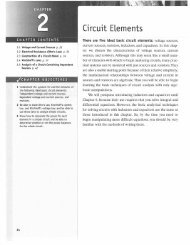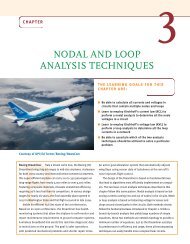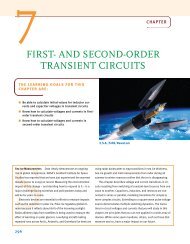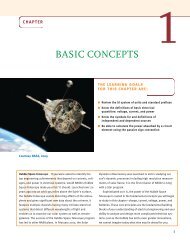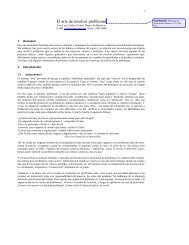Fundamentals of Electric Circuits
Fundamentals of Electric Circuits
Fundamentals of Electric Circuits
You also want an ePaper? Increase the reach of your titles
YUMPU automatically turns print PDFs into web optimized ePapers that Google loves.
3.9 Applications: DC Transistor <strong>Circuits</strong> 109<br />
where I E , I C , and I B are emitter, collector, and base currents, respectively.<br />
Similarly, applying KVL to Fig. 3.39(b) gives<br />
(3.28)<br />
where V CE , V EB , and V BC are collector-emitter, emitter-base, and basecollector<br />
voltages. The BJT can operate in one <strong>of</strong> three modes: active,<br />
cut<strong>of</strong>f, and saturation. When transistors operate in the active mode, typically<br />
V BE 0.7 V,<br />
I C a I E<br />
(3.29)<br />
where a is called the common-base current gain. In Eq. (3.29),<br />
a denotes the fraction <strong>of</strong> electrons injected by the emitter that are collected<br />
by the collector. Also,<br />
(3.30)<br />
where b is known as the common-emitter current gain. The a and b<br />
are characteristic properties <strong>of</strong> a given transistor and assume constant<br />
values for that transistor. Typically, a takes values in the range <strong>of</strong> 0.98 to<br />
0.999, while b takes values in the range <strong>of</strong> 50 to 1000. From Eqs. (3.27)<br />
to (3.30), it is evident that<br />
I E (1 b)I B<br />
(3.31)<br />
and<br />
V CE V EB V BC 0<br />
I C bI B<br />
b <br />
a<br />
1 a<br />
(3.32)<br />
These equations show that, in the active mode, the BJT can be modeled<br />
as a dependent current-controlled current source. Thus, in circuit analysis,<br />
the dc equivalent model in Fig. 3.40(b) may be used to replace the<br />
npn transistor in Fig. 3.40(a). Since b in Eq. (3.32) is large, a small base<br />
current controls large currents in the output circuit. Consequently, the<br />
bipolar transistor can serve as an amplifier, producing both current gain<br />
and voltage gain. Such amplifiers can be used to furnish a considerable<br />
amount <strong>of</strong> power to transducers such as loudspeakers or control motors.<br />
B<br />
+<br />
V CB<br />
−<br />
B<br />
+<br />
V BE<br />
−<br />
I B<br />
(a)<br />
C<br />
E<br />
C<br />
E<br />
+<br />
−<br />
I C<br />
I E<br />
V CE<br />
(b)<br />
Figure 3.39<br />
The terminal variables <strong>of</strong> an npn transistor:<br />
(a) currents, (b) voltages.<br />
In fact, transistor circuits provide motivation<br />
to study dependent sources.<br />
C<br />
B<br />
+<br />
+<br />
+<br />
I B V BE<br />
bI B<br />
−<br />
B V<br />
+ CE<br />
V BE −<br />
−<br />
−<br />
E<br />
E<br />
(a)<br />
(b)<br />
Figure 3.40<br />
(a) An npn transistor, (b) its dc equivalent model.<br />
It should be observed in the following examples that one cannot<br />
directly analyze transistor circuits using nodal analysis because <strong>of</strong> the<br />
potential difference between the terminals <strong>of</strong> the transistor. Only when the<br />
transistor is replaced by its equivalent model can we apply nodal analysis.<br />
I B<br />
I C<br />
V CE<br />
C






